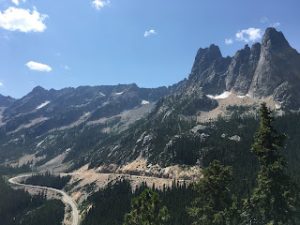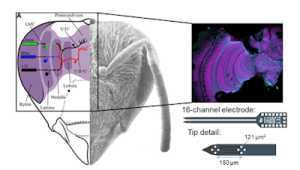Haiku:Fresh water brings plantslowers carbon dioxidein San Juan Islands
Global carbon dioxide (CO2) pollution from cars, airplanes, and coal plants influence the Salish Sea in multiple ways. As you may know, CO2 is causing global warming by acting as a greenhouse gas. CO2 also causes ocean acidification by dissolving in seawater. More acidic ocean conditions make it more difficult for some marine organisms to grow and make shells. Regionally, warming may also influence the timing and magnitude of river influence in the San Juan Archipelago. All of these changes may interact and have cascading effects on organisms in the region.
Over the past few years a group of scientists at the University of Washington’s marine station, Friday Harbor Laboratories, on San Juan Island, found that the seawater flowing around the lab docks often had twice as much CO2 as the atmosphere.1 This means that the organisms living in this water are living in conditions similar to what is expected globally 100 years from now.Where did the extra CO2 come from, you might ask? This seawater is old and has spent hundreds of years below the ocean surface where microbes and animals have added CO2 into the water. This deep water is brought upwards towards the surface through a process called upwelling. This deep water upwells near the outer coast of Washington – caused by a combination of winds and the turning of the earth (Coriolis force). This deep upwelled water travels East through the Strait of Juan de Fuca (in red, Fig 1).
Seawater conditions in the San Juan Islands are dynamic in that they change over the course of hours, weeks, and months. River-influenced water from BC, Canada also ventures South to the San Juan Islands during the spring and summer (in blue, Fig 1). These water masses mix and slosh back and forth with the winds and tides around the San Juan Islands, and cause dynamic changes in seawater conditions. While some patterns in seawater conditions had been observed over the course of a month, other patterns may only be seen with more frequent sampling. Working with Emily Carrington and Moose O’Donnell, I began measuring pH hourly.
Algae in the water, including the tiny plants known as phytoplankton, have the ability to take up CO2 in photosynthesis as they harness the sun’s energy to make sugars. When phytoplankton take up enough CO2, there may be less CO2 in the water. We noticed that pH was higher in the daytime and lower in the nighttime. This was exciting because it meant that we were able to observe the CO2 drawdown by photosynthesizing plants in the day and CO2 respired, or “breathed out”, by both animals and plants at night.We then started to notice large swings in pH that occurred when fresher, river-influenced water sloshed southward from Canada. We were surprised! Fresher water is often a source of CO2 (i.e. from microbes living in stream bed sediment). Fresher water is also not as buffered against changes in pH, and is generally more acidic than seawater (neutral pH). This was opposite to what we observed; slightly fresher water was less acidic. Perhaps there were more phytoplankton photosynthesizing and taking up CO2 in this fresher water body?
To answer this question, I collaborated with Alex Lowe and Aaron Galloway, who had collected a wealth of phytoplankton abundance and phytoplankton fatty acid (nutritional food quality) data. We had similar questions: is there a salinity threshold below which there are more phytoplankton and higher pH? If so, why? Putting our data together we found that pH was higher during fresher water events, and there were more phytoplankton in the water (Fig 2, Fig. 3).2 These phytoplankton were also of a higher nutritional quality. Changes in phytoplankton quantity and nutritional quality may enhance growth and buffer stressful conditions for filter feeders such as mussels and oysters, and this in turn may have cascading effects on multiple organisms in the food web such as seabirds and sea stars.
The Fraser River, which supplies fresh water to the Strait of Georgia, may experience changes in seasonal run-off from snowmelt. Over the past 50 years, the number of low salinity days in the spring and summer in the San Juan Archipelago has increased. In the San Juan Islands we may not only expect ocean warming and ocean acidification, but we may also expect to observe changes in the amount of phytoplankton and pH in surface water related to changes in snowmelt in the Canadian Rockies!
Our paper is available open access in Limnology and Oceanography. Many people, including Friday Harbor Labs graduate and undergraduate students, faculty, and technicians were integral to helping us collect and interpret this data and in supporting us in writing this paper. Read the Friday Harbor Labs tide-bites for an amazing behind-the-scenes story.
——————1 Murray, J.W., Roberts, E., Howard, E., O’Donnell, M., Bantam, C., Carrington, E., Foy, M., Paul, B. and Fay, A., 2015. An inland sea high nitrate‐low chlorophyll (HNLC) region with naturally high pCO2. Limnology and Oceanography, 60(3), pp.957-966. [link]
2 Lowe, A.T., Roberts, E.A. and Galloway, A.W., 2016. Improved marine‐derived POM availability and increased pH related to freshwater influence in an inland sea. Limnology and Oceanography. [link]


